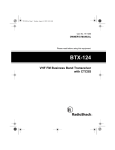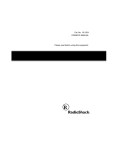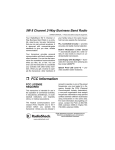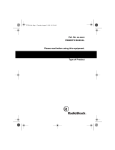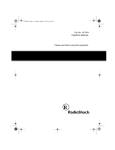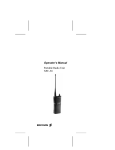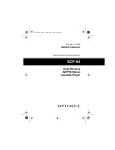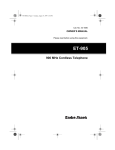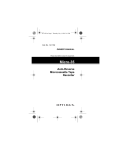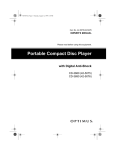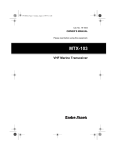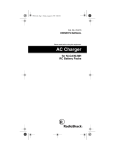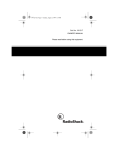Download Radio Shack BTX-127 Owner`s manual
Transcript
19-1206.fm Page 1 Tuesday, August 3, 1999 10:50 AM Cat. No. 19-1206 OWNER’S MANUAL Please read before using this equipment. BTX-127 CTCSS • VHF/FM Business Band Transceiver 19-1206.fm Page 2 Tuesday, August 3, 1999 10:50 AM Features Your RadioShack BTX-127 CTCSS • VHF/FM Business Band Transceiver is a portable, two-way business radio service transceiver that you can carry almost anywhere. The transceiver is compact and light, making it an ideal choice for your business needs. Your transceiver has these features: Programmable Frequencies — an authorized service facility can program the transceiver to any VHF business band frequency you have a license to use — no crystals to buy! Note: Your local RadioShack store must send the transceiver to an authorized service facility to program the transceiver with a frequency. You must show your license to store personnel. High/Low Power Switch — lets you increase the transmitted signal strength to increase the transceiver’s range, or decrease it to save battery power. Earphone/Speaker Jack and External Microphone Jack — let you connect an external earphone or speaker and an external microphone to help ensure understandable communications in noisy areas. Built-In Modulation Limiter Circuit — automatically adjusts for a wide variety of voice levels to ensure an understandable transmission. Battery Low Indicator — shows the battery pack’s condition. 38-Tone CTCSS (Continuous Tone Control Squelch System) — helps reduce interference from other transceivers which are operating on the same frequency, in the same area. Rechargeable Long-Life Battery Pack and Battery Charger — the supplied battery charger lets you conveniently recharge your transceiver’s long-life battery pack while it is on the transceiver. PLL-Controlled Circuitry — provides accurate and stable channel selection. © 1998 Tandy Corporation. All Rights Reserved. 2 19-1206.fm Page 3 Tuesday, August 3, 1999 10:50 AM Flexible Antenna — provides excellent reception. Belt Clip — lets you attach the transceiver to your belt or waistband. WARNING: To reduce the risk of fire or shock hazard, do not expose this product to rain or moisture. The transceiver’s preset frequencies are: • • • • • • • • • 151.625 MHz (red dot) 151.700 MHz 151.760 MHz 151.820 MHz 151.880 MHz 151.940 MHz 151.955 MHz (purple dot) 154.570 MHz (blue dot) 154.600 MHz (green dot) Note: Some manufacturers identify some business band frequencies by color. These “dot” frequencies are shown above. CAUTION RISK OF ELECTRIC SHOCK. DO NOT OPEN. ! CAUTION: TO REDUCE THE RISK OF ELECTRIC SHOCK, DO NOT REMOVE COVER OR BACK. NO USER-SERVICEABLE PARTS INSIDE. REFER SERVICING TO QUALIFIED PERSONNEL. This symbol is intended to alert you to the presence of uninsulated dangerous voltage within the product’s enclosure that might be of sufficient magnitude to constitute a risk of electric shock. Do not open the product’s case. We recommend you record your transceiver’s serial number here. The number is on the back of the transceiver. Serial Number _________________ ! This symbol is intended to inform you that important operating and maintenance instructions are included in the literature accompanying this product. 3 19-1206.fm Page 4 Tuesday, August 3, 1999 10:50 AM CONTENTS FCC Regulations ..................................................................................................... FCC License Required ..................................................................................... FCC Part 90 Rules ........................................................................................... Additional FCC Regulations ............................................................................. 5 5 5 7 Preparation .............................................................................................................. 8 Installing the Battery Pack ................................................................................ 8 Charging the Battery Pack ............................................................................... 9 Connecting the Antenna ................................................................................. 10 Connecting an Optional Antenna ............................................................ 11 Using the Belt Clip .......................................................................................... 11 Connecting an Earphone/External Speaker ................................................... 11 Listening Safely ....................................................................................... 12 Traffic Safety ........................................................................................... 12 Using an External Speaker/Microphone ......................................................... 12 Setting Frequency Options .................................................................................... 13 About CTCSS ................................................................................................. 13 Using a CTCSS Frequency ............................................................................ 14 Operation ............................................................................................................... 16 Operational Hints ............................................................................................ 17 Care and Maintenance .......................................................................................... 18 Specifications ......................................................................................................... 19 4 19-1206.fm Page 5 Tuesday, August 3, 1999 10:50 AM FCC Regulations FCC License Required To receive: This transceiver is intended for use in the operation of commercial activities, educational, philanthropic, or ecclesiastical institutions, and hospitals, clinics, or medical associations. All forms and instructions Form 600 instructions only Main Form 600 only Form 600 schedules only The Federal Communications Commission (FCC) requires you to have a license before you operate this transceiver. Unless you are already licensed to operate on one of the preset frequencies, you must apply for a frequency through the PCIA (Personal Communication Industry Association), a non-profit organization that assigns frequencies nationwide to help prevent conflicts between different businesses using transceivers in the same area. For more information about getting a license, contact the PCIA at 800-759-0300, extension 3068 (in Virginia 703-739-0300, extension 3068). You enter: 000600 006001 006002 006003 If you do not have a fax machine, you can call the Government Forms Distribution Center at 1-800-418-FORM and request that the form and instructions be mailed to you. FCC Part 90 Rules You must be familiar with Part 90 of FCC Rules before you operate your transceiver. The operation instructions in this manual conform to Part 90, but do not cover all items in Part 90. Overall, Part 90 states that: • You must have a valid license before you use the transceiver. For other questions concerning the license application, contact the FCC at 717-337-1212, or write: FCC P.O. Box 1040 Gettysburg, PA 17325 For the latest FCC application form and instructions, call the FCC’s fax-on-demand service at 1-202-418-0177 from a fax machine and request one or more of the following documents: 5 19-1206.fm Page 6 Tuesday, August 3, 1999 10:50 AM • As licensee, you are responsible for proper operation of all transceivers operating under your license authority. • You can let unlicensed persons operate this transmitter, as long as you take precautions to prevent unauthorized transmissions. • You must use this transceiver only for the commercial use of your business, and only when other commercial channels (such as the telephone) are either not available or not practical. • You must always yield the operating frequency to communications that involve the safety of life or property. • You must take reasonable precautions to prevent harmful interference to other services operating on the same frequency. • You must not transmit program material of any kind used in connection with commercial broadcasting. 6 • You must not provide a service that is normally handled by telephone or telegraph unless such broadcasts involve the safety of life or property or in emergencies such as an earthquake, hurricane, flood or a similar disaster where normal communication channels are disrupted. • During each transmission or exchange of transmissions, you must identify your station with the call sign issued to you by the FCC, or once each 15 minutes during periods of continuous operation. • You must keep a written record of any maintenance or modification made to the transceiver, and you must make this record available for inspection upon demand by the FCC. Violating any of the provisions of Part 90 can result in fines and/or confiscation of equipment. 19-1206.fm Page 7 Tuesday, August 3, 1999 10:50 AM Your transceiver might cause TV or radio interference even when it is operating properly. To determine whether your transceiver is causing the interference, turn off your transceiver. If the interference goes away, your transceiver is causing it. Try to eliminate the interference by: • moving your transceiver away from the receiver • contacting your local RadioShack store for help Before you operate the transceiver, you must obtain your license. It is illegal to transmit without the appropriate license, which you can get by submitting a completed FCC Form 600 to the FCC (or through the PCIA). Furthermore, you are required to understand Part 90 of the FCC Rules and Regulations prior to operating your transceiver. It is the user’s responsibility to see that this unit is operating at all times in accordance with the FCC Rules and Regulations. If you cannot eliminate the interference, the FCC requires that you stop using your transceiver. Additional FCC Regulations The Business Radio Service is under the jurisdiction of the Federal Communications Commission (FCC). Any adjustments or alterations that would alter the performance of the transceiver so it no longer meets the original FCC type acceptance or would change the frequency-determining method are strictly prohibited. Replacement or substitution of crystals, transistors, ICS, regulator diodes, or any other component that is of a unique nature with components other than those recommended can violate the technical regulations of the FCC rules or violate type acceptance requirement of the rules. 7 19-1206.fm Page 8 Tuesday, August 3, 1999 10:50 AM Preparation Installing the Battery Pack The supplied battery pack, when fully charged, provides power to your transceiver for up to 8 hours. You must install the battery pack in your transceiver, then charge it. Caution: Do not remove the plastic wrap from the battery pack. Doing so can permanently damage the battery. the battery pack into the compartment while applying slight pressure to the bottom of the battery pack. illus - show battery pack being installed into compartment Follow these steps to install the battery pack. 1. Unlock the battery compartment cover by sliding both of the cover’s latches toward the front of the transceiver as shown. Then slide the cover in the direction of the arrow and lift it off. 3. Slide the battery cover back into place, then slide both of the latches toward the back of the transceiver to lock it. To remove the battery pack, unlock the compartment, then turn the transceiver face down and gently tap it into your palm so the battery pack slides out. illus - show bat comp cover latches being released and cover being slid down 2. With the battery printing facing up, align the contacts on the battery pack with the contacts inside the battery compartment. Then, press 8 19-1206.fm Page 9 Tuesday, August 3, 1999 10:50 AM Charging the Battery Pack Before you use the battery pack for the first time, you must use the supplied battery charger to charge it for about 12 to 14 hours to bring it to a full charge. You cannot use the transceiver while you charge the battery pack. Caution: The supplied battery charger was designed specifically for your transceiver. Use only the supplied battery charger. Follow these steps to charge the battery pack. 1. Turn VOLUME fully counterclockwise to OFF to make sure power is turned off. illus show VOLUME other end of the charger into a standard AC outlet. illus - show barrel plug/ charger. Show plug being plugged into CHRG and AC plug about to be plugged into an AC outlet If the RX/TX indicator lights yellow when the transceiver’s power is on and you press PUSH TO TALK, recharge the battery pack. illus - show PTT and RX/TX lit on front of transceiver 2. Pull out the rubber cover over the CHRG jack on the side of the transceiver, and insert the charger’s barrel plug into the jack. Then plug the 9 19-1206.fm Page 10 Tuesday, August 3, 1999 10:50 AM Notes: • A nickel-cadmium battery pack lasts longer and delivers more power if you occasionally let it fully discharge. To do this, use the transceiver until the RX/TX indicator lights yellow when you press PUSH TO TALK. • To prevent damaging a nickel-cadmium battery pack, never charge it in an area where the temperature is above 113°F (45°C) or below 32°F (0°C). Important: At the end of a rechargeable battery pack’s useful life, it must be recycled or disposed of properly. Contact your local, county, or state hazardous waste management authorities for information on recycling or disposal programs in your area. Some options that might be available are: municipal curbside collection, drop-off boxes at retailers such as your local RadioShack store, recycling collection centers, and mailback programs. 10 Connecting THE Antenna Follow these steps to attach the supplied flexible antenna to your transceiver. illus - show antenna being connected to transmitter 1. Align the slots around the antenna’s connector with the tabs on the antenna jack on top of the transceiver. 2. While squeezing the base of the antenna, press the antenna down over the jack and turn the antenna’s base clockwise until it locks into place. 19-1206.fm Page 11 Tuesday, August 3, 1999 10:50 AM Connecting an Optional Antenna Although the supplied flexible antenna provides excellent local reception, you can connect an optional external mobile antenna or outdoor base station antenna to your transceiver for better reception of weak signals. The antenna jack on the top of the transceiver makes it easy to use the transceiver with a variety of antennas. Your local RadioShack store sells a variety of antennas. Caution: Never connect an antenna that is not specifically tuned for the transceiver’s frequency range. Using the Belt Clip The supplied belt clip lets you easily clip the transceiver to your belt. illus - show belt clip being attached to transceiver with screws Connecting an Earphone/External Speaker To listen privately or to hear better in a large area such as a warehouse, you can plug a monaural earphone or an 1 external speaker with a /8-inch (3.5 mm) plug (not supplied) into the EAR jack on thetop of the transceiver. This automatically disconnects the built-in speaker. Use a Phillips screwdriver to secure the clip to the transceiver’s back with the supplied screws. illus - show earphone/speaker being connected to EAR 11 19-1206.fm Page 12 Tuesday, August 3, 1999 10:50 AM Listening Safely To protect your hearing, follow these guidelines when you use an earphone. • Set the volume to the lowest setting before you begin listening. After you begin listening, adjust the volume to a comfortable level. • Do not listen at extremely high volume levels. Extended high-volume listening can lead to permanent hearing loss. • Once you set the volume, do not increase it. Over time, your ears adapt to the volume level, so a volume level that does not cause discomfort might still damage your hearing. Traffic Safety Do not use an earphone with your transceiver when operating a motor vehicle or riding a bicycle in or near traffic. Doing so can create a traffic hazard and could be illegal in some areas. If you use an earphone with your transceiver while riding a bicycle, be very careful. Do not listen to a continuous broadcast. Even though some earphones let you hear some outside sounds when listening at normal volume levels, they still can present a traffic hazard. 12 Using an External Speaker/ Microphone An external speaker/microphone can make it easier to use the transceiver when you clip it to your belt, so you do not have to lift the transceiver to your mouth each time you transmit. Plug the speaker/microphone’s plug into the EAR jack and the MIC jack on top of the transceiver. This automatically disconnects the transceiver’s built-in speaker and microphone. illus - show ext. speaker/ mike being connected to top of transceiver 19-1206.fm Page 13 Tuesday, August 3, 1999 10:50 AM Setting Frequency Options Before you can use your transceiver, an authorized service facility must set your transceiver to a VHF business band frequency you have a license to use. Then, you can select a preset CTCSS (Continuous Tone Control Squelch System) frequency and set your transceiver to use it. Here is what you need to do to set your transceiver to use a business band frequency and CTCSS. þ Send your transceiver to an authorized service facility to have it set to a business band frequency. À Set the DIP switches for a CTCSS frequency (see “Using a CTCSS Frequency” on Page 14). Ã Set your transceiver to that CTCSS frequency. Õ Set a DIP switch to activate or deactivate CTCSS. You can select one CTCSS frequency at a time. If you do not want to use a CTCSS frequency, skip Steps 2_4 above. About CTCSS CTCSS helps eliminate interference between different users of the same frequency, letting you talk and listen to people who are using other transceivers set to the same frequency and CTCSS code. This is like having a subchannel within a channel, giving you greater communication flexibility. When you set a CTCSS code — there are 38 to choose from — and turn on your transceiver’s CTCSS, the transceiver transmits a tone with your transmission, letting you communicate with anyone who has a transceiver set to the same frequency and code. This tone is too low for you to hear, but other transceivers can detect it. If CTCSS is turned on and set to the same tone on the receiving transceiver, it only receives those transmissions that include the tone. If two different groups oper-ate transceivers in the same area on the same frequency, they do not hear each other’s broadcasts if they both use CTCSS and each select a different CTCSS tone. Your transceiver’s default CTCSS tone is 100 Hz. 13 19-1206.fm Page 14 Tuesday, August 3, 1999 10:50 AM CTCSS Using a CTCSS Frequency Follow these steps to set your transceiver to a CTCSS frequency and then activate or deactivate CTCSS. 1. Turn VOLUME fully counterclockwise to make sure power is turned off. 2. Remove the battery compartment cover (see “Installing the Battery Pack” on Page 8). You do not have to remove the battery pack. 3. Choose a CTCSS code from the table on the right. Then use a pointed object such as a straightened paper clip to set the position of each DIP switch inside the battery compartment to 1 (up) or 0 (down) corresponding to the setting for that CTCSS code. illus - show DIP switch inside battery compartment set to any setting Dip Switch Setting Key: 0 = down 1 = up none 1 67.0 000001 2 71.9 000010 3 74.4 000011 4 77.0 000100 5 79.7 000101 6 82.5 000110 7 85.4 000111 8 88.5 001000 9 91.5 001001 10 94.8 001010 11 97.4 001011 12 100.0 001100 13 103.5 001101 14 107.2 001110 15 110.9 001111 16 114.8 010000 17 118.8 010001 18 123.0 010010 19 127.3 010011 20 131.8 010100 21 136.5 010101 22 141.3 010110 23 146.2 010111 24 151.4 011000 CTCSS Code 14 Freq (Hz) DIP Switch Setting 000000 Code 25 Freq (Hz) 156.7 DIP Switch Setting 011001 19-1206.fm Page 15 Tuesday, August 3, 1999 10:50 AM (up). To deactivate the code, set the switch to 0 (down). CTCSS 26 162.2 011010 27 167.9 011011 28 173.8 011100 29 179.9 011101 30 186.2 011110 31 192.8 011111 32 203.5 100000 33 210.7 100001 34 218.1 100010 35 225.7 100011 36 233.6 100100 37 241.8 100101 38 250.3 100110 6. Replace the battery compartment cover. 4. Hold down PUSH TO TALK, then turn VOLUME clockwise until it clicks. The transceiver sets the CTCSS code. Release PUSH TO TALK. If the transceiver beeps once and RX/TX lights green for about 2 seconds, that means the CTCSS setting was successful. If the transceiver beeps 3 times and RX/TX lights red for about 2 seconds, the CTCSS setting did not work. Start over at Step 1. 5. To activate the CTCSS code you set, set the first DIP switch to 1 15 19-1206.fm Page 16 Tuesday, August 3, 1999 10:50 AM Operation Note: You can only communicate with another transceiver that is using the same channel and/or the same CTCSS code as your transceiver. 1. Turn VOLUME clockwise to turn on the transceiver, turn SQUELCH fully counterclockwise until you hear a hissing sound, then adjust the volume to a comfortable listening level. illus - show VOLUME being adjusted 2. If you did not set the transceiver to use a CTCSS code, wait until there is no signal on the channel. Then turn SQUELCH clockwise until the background noise between signals stops. 3. To conserve battery power, slide HI/LO to LO. If the person you transmit to has trouble receiving your signal, slide HI/LO to HI. illus - show HI/LO switch 4. To transmit, hold down PUSH TO TALK. Then hold the transceiver about 3 inches from your mouth and speak slowly in a normal voice. The RX/TX indicator lights red. illus - show PUSH TO TALK and RX/TX indicator 5. Release PUSH TO TALK when you finish your transmission. illus - show SQUELCH being adjusted 16 6. To turn off the transceiver, turn VOLUME counterclockwise until it clicks. 19-1206.fm Page 17 Tuesday, August 3, 1999 10:50 AM Operational Hints Your transceiver’s range varies depending on factors such as position, terrain, and battery condition. Buildings absorb transmitted signals and, if they contain metal, might completely block the signals. Trees and heavy cloud formations have a similar effect, though not as severe. If you are near a lake or the ocean, you might get excellent range. To ensure maximum range, operate the transceiver with the battery pack fully charged. As the voltage decreases, the range decreases. 17 19-1206.fm Page 18 Tuesday, August 3, 1999 10:50 AM Care AND Maintenance Your RadioShack BTX-127 CTCSS • VHF/FM Business Band Transceiver is an example of superior design and craftsmanship. The following suggestions will help you care for your transceiver so you can enjoy it for years. • Keep the transceiver dry. If it gets wet, wipe it dry immediately. Liquids might contain minerals that can corrode the electronic circuits. • Use and store the transceiver only in normal temperature environments. Temperature extremes can shorten the life of electronic devices, damage batteries, and distort or melt plastic parts. • Keep the transceiver away from dust and dirt, which can cause premature wear of parts. • Handle the transceiver gently and carefully. Dropping it can damage circuit boards and cases and can cause the transceiver to work improperly. • Use only a battery pack of the required size and type. Battery packs can leak chemicals that damage your transceiver’s electronic parts. • Wipe the transceiver with a damp cloth occasionally to keep it looking new. Do not use harsh chemicals, cleaning solvents, or strong detergents to clean the transceiver. Modifying or tampering with the transceiver’s internal components can cause a malfunction and might invalidate your transceiver’s warranty and void your FCC authorization to operate it. If your transceiver is not performing as it should, take it to your local RadioShack store for assistance. 18 19-1206.fm Page 19 Tuesday, August 3, 1999 10:50 AM Specifications Frequency Range ................................................................... 150.775–157.740 MHz Channels ................................................................................................................... 1 Modulation Type .................................................................................................... FM Antenna Impedance ....................................................................................... 50 Ohm Microphone ...................................................................................... Condenser Type Power Supply ....................................................... 7.2V 950 mAh Ni-Cd Battery Pack Note: The supplied battery charger does not operate at temperatures below 32°F (0°C) or above 113°F (45°C). Sensitivity at 12dB SINAD ................................................................................ 0.5 µV Bandwidth .................................................................................................... 12.5 KHz Adjacent Channel Rejection .............................................................................. 45 dB Audio Output Power ............................................. 200mW @ 8 ohm (10% distortion) Audio Distortion .................................................................................................... 7 % Transmit Power ............................................................................................... Hi: 2W Lo: 600 mW Harmonic Emission ........................................................................................... 55 dB 1 3 9 Dimensions (HWD) .......................................................... 5 /2 × 2 /8 × 1 /16 Inches (140 × 60 × 35 mm) Weight (with battery pack) .................................................................................. 14 oz (0.4 kg) Specifications are typical; individual units might vary. Specifications are subject to change and improvement without notice. 19 19-1206.fm Page 20 Tuesday, August 3, 1999 10:50 AM Limited One-Year Warranty This product is warranted by RadioShack against manufacturing defects in material and workmanship under normal use for one (1) year from the date of purchase from RadioShack company-owned stores and authorized RadioShack franchisees and dealers. EXCEPT AS PROVIDED HEREIN, RadioShack MAKES NO EXPRESS WARRANTIES AND ANY IMPLIED WARRANTIES, INCLUDING THOSE OF MERCHANTABILITY AND FITNESS FOR A PARTICULAR PURPOSE, ARE LIMITED IN DURATION TO THE DURATION OF THE WRITTEN LIMITED WARRANTIES CONTAINED HEREIN. EXCEPT AS PROVIDED HEREIN, RadioShack SHALL HAVE NO LIABILITY OR RESPONSIBILITY TO CUSTOMER OR ANY OTHER PERSON OR ENTITY WITH RESPECT TO ANY LIABILITY, LOSS OR DAMAGE CAUSED DIRECTLY OR INDIRECTLY BY USE OR PERFORMANCE OF THE PRODUCT OR ARISING OUT OF ANY BREACH OF THIS WARRANTY, INCLUDING, BUT NOT LIMITED TO, ANY DAMAGES RESULTING FROM INCONVENIENCE, LOSS OF TIME, DATA, PROPERTY, REVENUE, OR PROFIT OR ANY INDIRECT, SPECIAL, INCIDENTAL, OR CONSEQUENTIAL DAMAGES, EVEN IF RadioShack HAS BEEN ADVISED OF THE POSSIBILITY OF SUCH DAMAGES. Some states do not allow the limitations on how long an implied warranty lasts or the exclusion of incidental or consequential damages, so the above limitations or exclusions may not apply to you. In the event of a product defect during the warranty period, take the product and the RadioShack sales receipt as proof of purchase date to any RadioShack store. RadioShack will, at its option, unless otherwise provided by law: (a) correct the defect by product repair without charge for parts and labor; (b) replace the product with one of the same or similar design; or (c) refund RadioShack A Division of Tandy Corporation Fort Worth, Texas 76102 10A8 Printed in Hong Kong




















